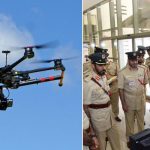How to Make Amazing Aerial Footage in Winter Leave a comment
How to Make Amazing Aerial Footage in Winter
Drone benefits are numerous. Yet still, regardless of the fact that drones are applied in different life spheres, their major purpose is to make amazing aerial footage. Nevertheless, winter weather isn’t the best for flying drones. In this review, we will learn how to make amazing footage and capture winter landscapes professionally. Look through our tips below:
- Icing
This is one of the major obstacles. Icing is the main enemy of drones. It can build up on the blades and increase the weight of a drone. As a result it influences negatively aerodynamic properties. This aspect should be taken into consideration, especially when you plan flying adobe rivers, seas or lakes.
- Battery Behavior.
When you fly a drone in winter, you need to know that the battery life will be shorter when it is cold outside. So, always plan your routes attentively and take this issue into consideration. If you have additional batteries, you should keep them warm, either in the pocket of your jacket, in your car or in a special bag for a drone.
As soon as you begin flying, start your motors and let the aircraft to hover for at least one minute. This is required to warm up the battery. If you own one of DJI drones, the UAV will notify you in case the temperature of a battery will be lower than 15 °C. Unfortunately, cold weather conditions can result in the drops of voltage.
- Dress yourself appropriately.
This advice is for pilots. Sometimes, the weather in winter is very cold. Flying a drone in certain aeries, you’ll be made to stand still for a long time. So, dress appropriately, and take gloves with capacitive fingertips with you.
- Density Altitude.
One of disadvantages of flying in winter is the density altitude in which you will be flying. Cold air is thicker and propellers are made to take a larger bite of air.
Unfortunately, winter means moisture – fog, snow or rain – almost each day the amount of airborne moisture is big. Such weather conditions aren’t friendly for the drone motors or its electronics. For that reason, our recommendations are the following:
- Don’t fly when it is raining, drones aren’t water resistant, so, it may lead to the drone crash.
- Avoid flying through fog. It may damage the motors and you will not see anything.
- Snowy weather isn’t good for flying too.
Besides, don’t forget about the protection of the screen of your controller and mobile device you use with your drone.
Because of the fact that almost all the time the weather is foggy or clouds are too low, there is always a threat of moisture. Furthermore, you may also face one more difficulty – you will not see your aircraft.
- White Balance.
You should always shoot raw. If you don’t do this, your camera’s exposure system can easily be tricked into underexposing snow. Besides, don’t forget about white balance, which can skew toward blue.
- Air
Yet still, it doesn’t mean that in winter you will not get amazing photos. The air is smoother in winter. For that reason, you have more chances to get more stable footage than in summer.
We hope that all these tips will help you solve all issues you faced or will face in the near future flying in winter. Following them, you’ll avoid lots of difficulties.
If right now you are on the stage of buying a drone for you, welcome to aeromotus.com. We offer a broad assortment of DJI drones for sale in Dubai at the best prices.



